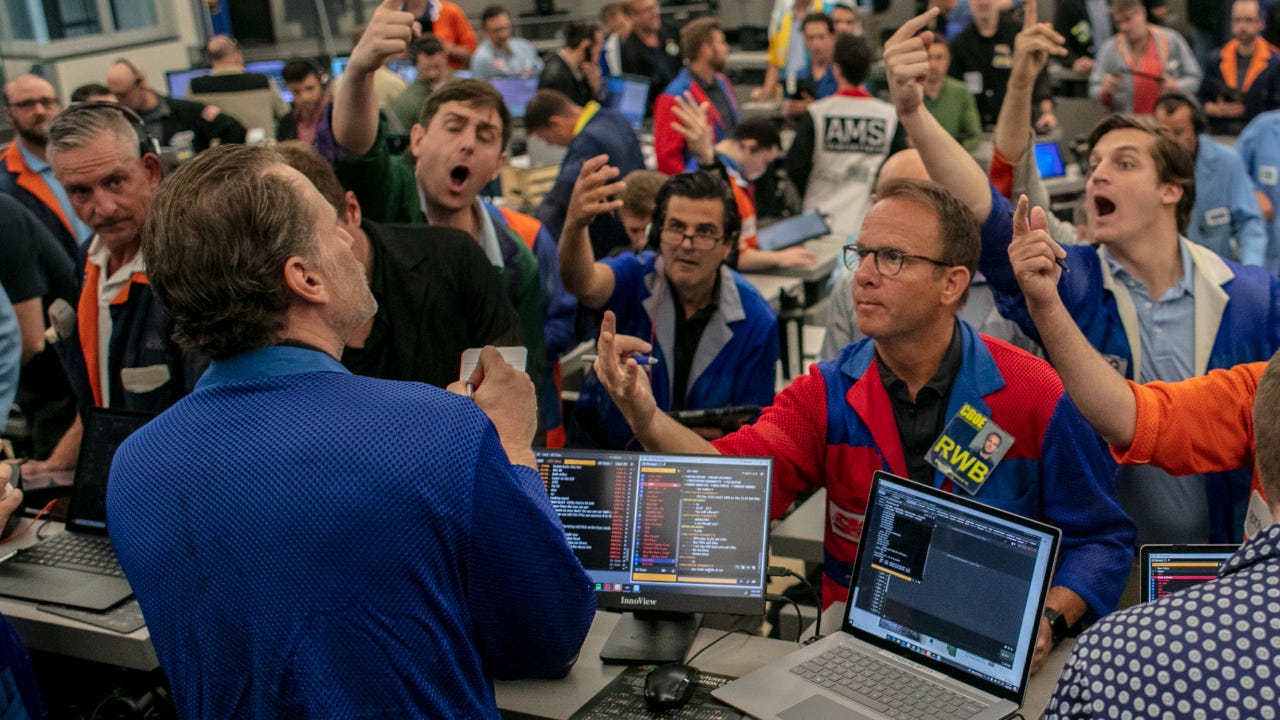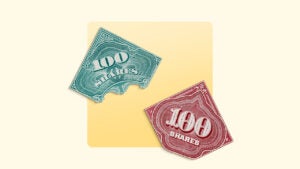Derivative investments: What they are and how they work

Our writers and editors used an in-house natural language generation platform to assist with portions of this article, allowing them to focus on adding information that is uniquely helpful. The article was reviewed, fact-checked and edited by our editorial staff prior to publication.
Derivatives are a kind of financial security that get their value from another underlying asset, such as the price of a stock, a commodity such as gold or even interest rates. Many kinds of derivatives exist and trading them is usually best left to highly skilled professional investors, though some brokers allow individual investors to trade at least some basic derivatives, too.
Here’s what derivatives are, how they work and their pros and cons.
What is a derivative?
The word derivative sounds fancy and perhaps a little intimidating. But the key thing to know about derivatives is that they are a financial contract whose value is derived from the value of another security, maybe even another derivative. For example, options are one kind of derivative, since their value is based on the performance of the underlying stock. So, the derivative has no value of its own apart from the value that it gets from the asset it’s priced on.
Because of this structure, derivatives typically have a fairly short lifespan, maybe as short as days or weeks and often no more than a few years. Again, options are a useful example here, because they have a finite lifetime, an expiration, that’s known from the outset. They can be traded when they have just hours left before they permanently cease to exist, and options – at least publicly traded ones – usually exist for no longer than a couple years or so.
Given the structure of an asset that is based on the performance of another asset, derivatives prices are often fast-moving, and traders often have the potential to make or lose a lot of money quickly. Fast money – that’s part of the appeal of trading options and futures, for example.
Based on that knowledge, perhaps it’s not too surprising that multiple kinds of derivatives – credit default swaps (CDS), for one – were at the center of the global financial crisis in 2008-2009.
While they can be risky, derivatives also have socially valuable uses. Instruments such as futures allow the producers of valuable but fluctuating commodities such as agricultural goods to lock in a price, helping to ensure some financial stability for companies in an unstable economy.
So derivatives can help some market participants reduce their risk and spread it to others who are willing to bear that risk in exchange for some kind of payment or premium.
In a real sense, derivatives are just a side bet between market participants on what’s going to happen in the markets. Derivatives are simply created out of other securities as a way to express a different financial need or a view on what will happen in the market. So, in theory, any number of derivatives could be created between investors based on existing financial securities.
Types of derivatives
Below are four of the most common types of derivatives that are traded on the market.
Futures
Futures are the obligation to take delivery of a good or commodity by a certain date. The standardized contract has a fixed expiration, after which it’s settled among the contract’s parties. Futures are traded on a wide variety of things, perhaps most famously, commodities such as oil, gold and soybeans. But they’re also used for currencies, interest rates and indexes, giving traders, financial companies and producers such as big agricultural firms a way to hedge their risk and ensure that they lock in a fixed price on some of their goods. Futures are settled on an exchange transparently, helping to reduce the risk that the counterparty can’t meet the contract.
The fast-paced futures market allows traders to put up a fraction of the money for a contract, meaning they can earn attractive returns without investing a lot of money. But if the trade moves against them, they’ll have to fork over more money to hold the position. This kind of leverage makes futures a popular place for knowledgeable and risk-seeking traders.
Forwards
Forwards are like futures, allowing traders to buy and sell the obligation to take delivery on commodities or other financial instruments. But whereas futures are standardized contracts sold on an exchange, forwards are non-standardized, trade over the counter and are not cleared by a central middleman, meaning that the counterparties in a contract take on greater risk. While the futures market is overseen by the Commodity Futures Trading Commission, the forwards market has little, if any, oversight, since they’re private contracts between third parties.
The upside of forwards is that market participants can buy a bespoke contract giving them exactly the exposure they want (if they can find someone to offer it). The downside is that they take on greater risk that the counterparty can’t meet its end of the deal and settle the contract.
Options
Options are the right to buy or sell a stock at a specific price (called the strike price) by a specific date. Options come in two major varieties: call options, which give you the right to buy a stock at a certain price, and put options, which give you the right to sell a stock at a certain price.
An option has a fixed expiration, after which its value is settled between the parties to the contract, and then the option ceases to exist. The option can expire with only two outcomes: it’s worth some amount of money or nothing, making options a high-risk, high-reward trade.
If you’re looking to trade options, check out the best brokers for options trading.
Swaps
Swaps are a kind of financial contract that allow counterparties to trade a series of cash flows between them. They don’t trade the underlying asset themselves, but instead typically make a contract to pay each other based on the net change in the cash flows being swapped. So, swaps allow market participants who have differing preferences to exchange their exposure to a given underlying asset. A swap is a contract between private parties and traded over the counter, so they’re not standardized nor cleared by a central middleman, creating greater counterparty risk.
A swap can be a derivative of several different underlying elements, including commodities, stocks, foreign exchange and interest rates. A typical swap contract might involve the exchange of a cash flow based on a fixed interest rate for a cash flow based on a floating rate, called an interest rate swap. Why do that? One party expects interest rates to fall and wants to swap its fixed-rate exposure for floating rate exposure to a party who expects rates to rise. So that swap acts as a side bet on rates. The net cash flow (the difference) is paid from one party to the other, according to the terms of the contract, but no actual debt is traded between the two parties.
With swaps, market participants can create bespoke exposure to exactly what they want, if they can find a counterparty to make the deal. The downside is greater counterparty risk, the chance that the counterparty cannot hold up its end of the bargain when it comes time to do so.
Pros and cons of derivatives
Derivatives can offer a variety of pros and cons to traders and the financial markets and society at large.
Pros
- Allows market participants to spread risk. Derivatives allow risk-seeking traders to match up with those looking to offload risk (say, of a harvest) in exchange for a fee. This is a socially valuable activity that helps reduce the market’s overall riskiness.
- Allows traders to speculate. Derivatives permit traders to speculate and potentially earn a profit if they guess where a market is moving, an advantage for the trader.
- Permits the use of leverage to increase gains. Traders can also benefit from the leverage in many derivatives contracts, allowing them to have a greater stake in an asset than they otherwise could with a given amount of money.
- Helps set the price of the underlying asset. The price of derivatives can provide worthwhile information to the market about the value of an underlying asset, helping with price discovery.
- Offers greater market efficiency. By allowing a greater range of market participants with varying viewpoints and risk appetites, derivatives markets can create more efficient markets for the underlying asset.
Cons
- Can be very risky and fast-moving. For individual traders, derivatives can be very fast-moving, with securities fluctuating significantly in hours or days, building fortunes and destroying them.
- May encourage speculative excess. While speculation can have positive effects for society, it may also create situations that increase the overall risk of the financial system and hurt the livelihoods of those affected by that speculation. For example, grain users may be severely hurt if speculators push up prices. A key element of the global financial crisis was unsophisticated traders rushing in to buy highly risky financial derivatives.
- May be exposed to counterparty risk. Counterparty risk is the risk that the other side of a derivative contract won’t be able to fulfill their end of the deal. This risk is less of an issue for derivatives such as futures contracts and options markets, which have a clearinghouse that monitors the financial wherewithal of the counterparties. But it can be a significant issue, especially in times of financial stress, for “over-the-counter” derivatives that rely exclusively on the strength of the counterparty to fulfill them.
How to buy and trade derivatives
Outside of options, trading derivatives is not something that’s especially popular with (or even possible for) individual investors. Sure, some traders try their hand at futures or some other derivatives. But even these markets are populated by sophisticated professional traders or companies that need to offload risk in their own operations to other market participants willing to take on that risk.
However, the key exceptions are options and futures, both of which are available at many online brokerages. Because of the leverage involved in derivatives, it’s important that you understand the risks involved with them. Many brokers have higher account minimums to access futures, and they require you to have greater knowledge and experience trading the market before you can access them. Options are easier to access at most brokerages and require less capital.
If you want to get started trading options or futures, investigate which broker meets your needs. Most major online brokerages allow you to trade options, even relatively simple financial apps such as Robinhood or Webull. Want to try your hand at futures? You’ll have a more limited selection of brokers, such as Charles Schwab and Interactive Brokers. If you’re looking to make futures trading part of a broader range of trading options such as stocks and funds.
Bottom line
While most investors have at least a passing familiarity with options, the most mainstream of derivatives, other derivatives are complex financial instruments that serve a specific business purpose for traders or companies. Given the strong potential returns from owning high-quality stocks, derivatives are not an area that most individuals even need to consider. But if you’re looking to just get a taste, individuals do have some options strategies that are low-risk.
Editorial Disclaimer: All investors are advised to conduct their own independent research into investment strategies before making an investment decision. In addition, investors are advised that past investment product performance is no guarantee of future price appreciation.
You may also like

Call vs. put options: How they differ





